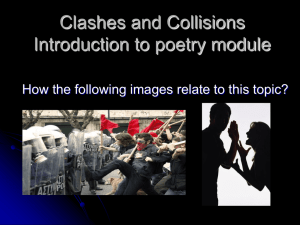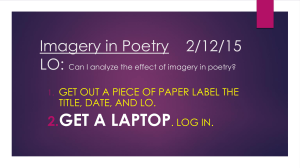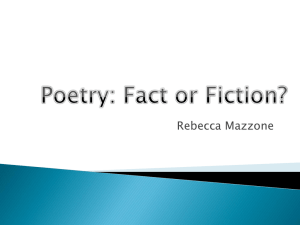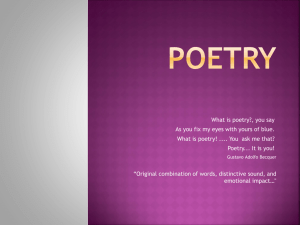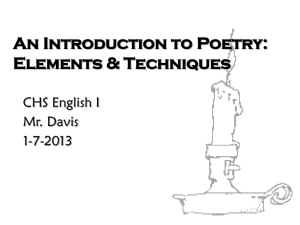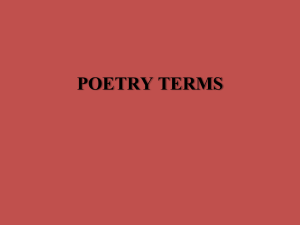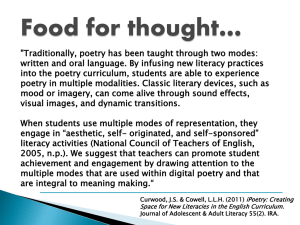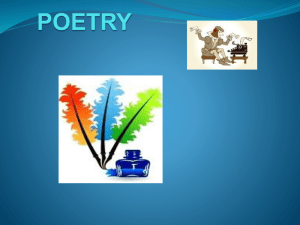POETRY
advertisement
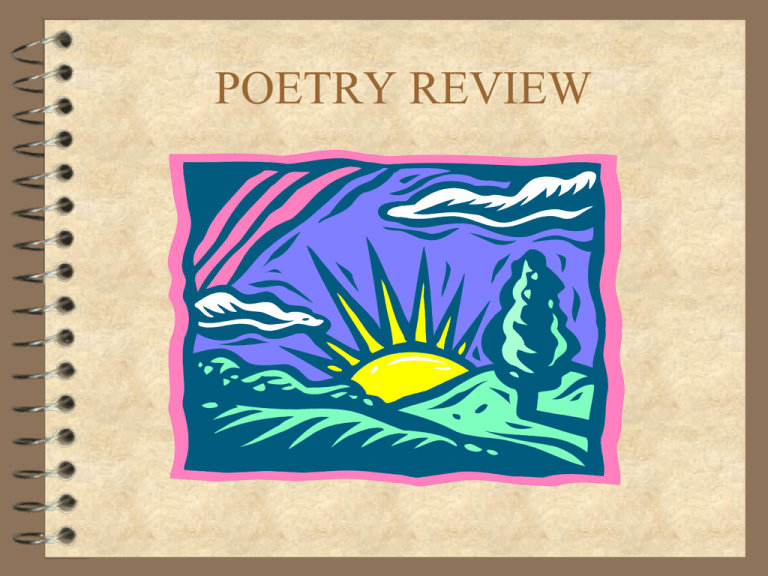
POETRY REVIEW POETRY A type of literature that expresses ideas, feelings, or tells a story in a specific form (usually using lines and stanzas) and sometimes appeals to the senses POINT OF VIEW IN POETRY POET SPEAKER First person uses words such as “I” and The poet is the author “me” and is told as of the poem. though the speaker is watching or was there Third person uses names and is told as if watching from afar POETRY FORM FORM - the appearance of the words on the page LINE - a group of words together on one line of the poem STANZA - a group of lines arranged together A word is dead When it is said, Some say. I say it just Begins to live That day. KINDS OF STANZAS Couplet Triplet (Tercet) Quatrain Quintet Sestet (Sextet) Septet Octave = = = = = = = a two line stanza a three line stanza a four line stanza a five line stanza a six line stanza a seven line stanza an eight line stanza FREE VERSE POETRY Unlike other types of poetry, free verse poetry does NOT have any repeating patterns of stressed and unstressed syllables. Does NOT have rhyme. Free verse poetry is very conversational sounds like someone talking with you. A more modern type of poetry. RHYME Words sound alike because they share the same ending vowel and consonant sounds. (A word always rhymes with itself.) LAMP STAMP Share the short “a” vowel sound Share the combined “mp” consonant sound END RHYME A word at the end of one line rhymes with a word at the end of another line Hector the Collector Collected bits of string. Collected dolls with broken heads And rusty bells that would not ring. ONOMATOPOEIA Words that imitate the sound they are naming BUZZ OR sounds that imitate another sound “The silken, sad, uncertain, rustling of each purple curtain . . .” “The babbling brook …. “ ALLITERATION Consonant sounds repeated at the beginnings of words If Peter Piper picked a peck of pickled peppers, how many pickled peppers did Peter Piper pick? SOME TYPES OF POETRY WE NEED TO REMEMBER Ode A poem that pays tribute to something or someone For example, “Ode to Mi Gato” – pays tribute to the speaker’s cat HAIKU A Japanese poem written in three lines Five Syllables Seven Syllables Five Syllables An old silent pond . . . A frog jumps into the pond. Splash! Silence again. NARRATIVE POEMS A poem that tells a story. Generally longer than the lyric styles of poetry because the poet needs to establish characters and a plot. Examples of Narrative Poems “Casey at the Bat” “The Sneetches” CONCRETE POEMS Also known as “shape” poems In concrete poems, the words are arranged to create a picture that relates to the content of the poem. Poetry Is like Flames, Which are Swift and elusive Dodging realization Sparks, like words on the Paper, leap and dance in the Flickering firelight. The fiery Tongues, formless and shifting Shapes, tease the imiagination. Yet for those who see, Through their mind’s Eye, they burn Up the page. FIGURATIVE LANGUAGE SIMILE A comparison of two things using “like” and “as” “She is as beautiful as a sunrise.” METAPHOR A direct comparison of two unlike things “She is an angel.” and “Its perfect oval is a poem.” Sometimes uses color metaphor (for example, “His crystal eyes sparkled as he spoke.” and “His fleck of granite eye”) Hyperbole Exaggeration often used for emphasis “I’ve asked you one million times to take out your homework!” –Mrs. Falanga, Mrs. Lagarde, Ms. Landreneau, Mr. Lemieux, and Mr. Wray Idiom An expression where the literal meaning of the words is not the meaning of the expression. It means something other than what it actually says. Ex. It’s raining cats and dogs. PERSONIFICATION Giving an animal or nonliving object human characteristics or qualities “The ocean sings its lovely song…” “The sky wept buckets all day long..” “His frowning beak…” OTHER POETIC DEVICES IMAGERY Language that appeals to the senses. Most images are visual, but they can also appeal to the senses of sound, touch, taste, or smell. then with cracked hands that ached from labor in the weekday weather . . . from “Those Winter Sundays”
